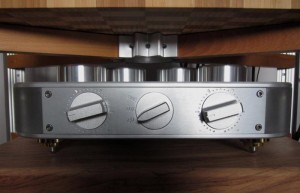I drove out into the wilds of Auckland’s far west to cadge a free lunch at Gary Steel’s house (and to hear what my StereoKnight Silverstone Balance TVC sounded like on a very different system).
Gary’s system is made up of  tin Logan Purity powered electrostatic speakers, a Yamaha CD-S2000 SACD player and a Rotel RC-1550 preamplifier. An initial listen to the system as it stood revealed screeds of detail, quite a neutral presentation tending towards a slight top end emphasis, just as I expected from the Martin Logans – I’ve heard this set before in this room albeit with a different source. There was plenty of bottom end weight and a big soundstage (as long as you’re smack in the middle of the sweet spot). In short, an enjoyable system that certainly ticks all the boxes.
tin Logan Purity powered electrostatic speakers, a Yamaha CD-S2000 SACD player and a Rotel RC-1550 preamplifier. An initial listen to the system as it stood revealed screeds of detail, quite a neutral presentation tending towards a slight top end emphasis, just as I expected from the Martin Logans – I’ve heard this set before in this room albeit with a different source. There was plenty of bottom end weight and a big soundstage (as long as you’re smack in the middle of the sweet spot). In short, an enjoyable system that certainly ticks all the boxes.
With the StereoKnight passive in the loop, things changed. The fundamental balance of the system didn’t swing to the dark side of the force or anything as dramatic but suddenly, a layer of glare or hash (for want of a better description) that I wasn’t really aware of was just gone.
The sound was more organic, more analogue without getting any added warmth and it was certainly more natural. It was way more transparent too – we could hear deeper into the recording with even more detail on offer as well as more clues as to the nature of the acoustic space and the recording process. Guitars now had the subtle touches of fingers on their strings and we had a more direct path to the way vocalists were shaping their words, drumbeats sounded more like a collections of sounds instead of one note events. Textures, inflections, air, space were all added to the playback or perhaps it’s more accurate to say that these things were no longer being subtracted.
This was all as clear as day but we were both puzzled by other aspects of what we were hearing. Gary commented that the StereoKnight seemed to lack the ability to convey the power of rock but we agreed that this wasn’t a result of any kind of weak dynamics. Rather I noted that the system just needed to be played at a higher volume level than he was used to, just as I’d found in my own system.
Once you start turning up the wick however, you find that there’s something strange going on here. Basically the sound is so “clean” that we we settled into listening with the levels up really loud, with no strain at all and no desire to turn it down. It was only when we tried to talk to each other that we registered just how loud the volume was; too loud for the SPL meter on my iPhone to track because it packs a sad at anything over 100dB peaks. When we turned the volume down a few notches, it was still loud but I could have listened all day.
As an aside, I’m listening to Neil Young’s Le Noise at home as I type this and it’s also louder than I’d normally listen to it, much louder and I’m loving it. I’m tempted to turn it up further but would like to avoid the neighbors running out me of the townhouse complex on a rail.
 So the dynamics are fine, maybe not as pronounced (over inflated?) as they are with an active preamp in the loop but something else demands that the music is played loud. I’ve heard this kind of thing before, most notably on a set of big Infinity speakers powered by Halcro amplification. More volume just made it better. At one point we had it up so loud that we were all clustered at the back of the room waiting for something to let go and the sound still felt just right. I need to spend more time working this one out…
So the dynamics are fine, maybe not as pronounced (over inflated?) as they are with an active preamp in the loop but something else demands that the music is played loud. I’ve heard this kind of thing before, most notably on a set of big Infinity speakers powered by Halcro amplification. More volume just made it better. At one point we had it up so loud that we were all clustered at the back of the room waiting for something to let go and the sound still felt just right. I need to spend more time working this one out…
Back to Gary’s place then – once we put the Rotel back in between the SACD player and the speakers, the glare returned. Don’t get me wrong, it wasn’t bad. In fact, it was plenty good indeed but there’s no doubt that the Rotel is adding its own contribution to the music, much as my Yamaha did in my system. The StereoKnight seems to be doing very little beyond moving electrical signals around, which is all it should bloody well be doing.
















Wow. Sounds very interesting! Great article.
Hi Gary,
It seems inevitable to me that what we call recorded music is in fact ‘ a bent wire with grain’. It is much easier to hear what a system adds to the sound than what it detracts.
The knack is in finding less intrusive additions or those that are in fact pleasant or even synergistic with some music such as the shine and edge that can go well with rock music.
You are honest enough to question whether a passive preamp works the other way so that something is lost or reduced. I resonate with that question. It is not just a technical question but also a psychological one. We are not geared so well to asking the question of what might be missing or compromised but that is an important question. Additions may irritate or excite short term but losses can lead to longterm lack of involvement. John.